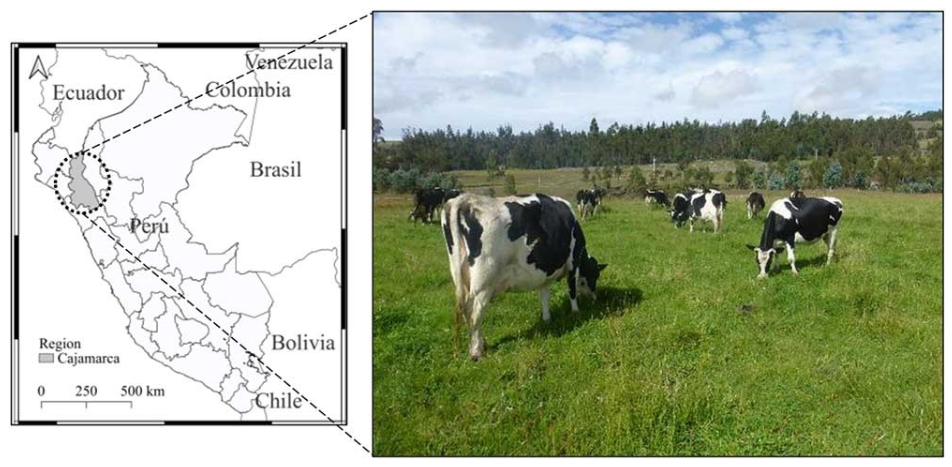Combined efficacy of ivermectin and triclabendazole against bovine fasciolosis
Main Article Content
Abstract
This study aimed to evaluate the combined efficacy of triclabendazole (TCBZ) and ivermectin (IVM) against Fasciola hepatica in dairy cattle. Four groups of 15 Holstein cattle were formed: the first was the control (T0); TCBZ (12 mg/kg b.w.) was administered orally in the second (T1); TCBZ, fenbendazole and IVM (12, 10 and 0.2 mg/kg b.w.) were administered orally in the third (T2); and TCBZ (12 mg/kg b.w.) was administered orally and IVM (0.2 mg/kg b.w.) was administered subcutaneously in the fourth group (T3). The efficacy observed was 51.75 % (95 % CI: 42.41 - 61.09) in T1, 56.64 % (95 % CI: 47.42 - 65.86) in T2 and 69.93 % (95 % CI: 61.40 - 78.46) in T3. IVM increased the efficacy of TCBZ by 9.45 % in T2 and 35.13 % in T3 compared to T1. Although the addition of IVM, whether administered orally or subcutaneously, enhanced the efficacy of TCBZ, this combination as a pharmacological control strategy for F. hepatica in dairy cattle in Cajamarca was not encouraging.
Article Details

This work is licensed under a Creative Commons Attribution-NonCommercial 4.0 International License.
National Center for Animal and Plant Health (CENSA)References
Gandhi P, Schmitt EK, Chen CW, Samantray S, Venishetty VK, Hughes D. Triclabendazole in the treatment of human fascioliasis: a review. Transactions of The Royal Society of Tropical Medicine and Hygiene. 2019;113(12): 797-804. https://doi.org/10.1093/trstmh/trz093.
Rodríguez-Hidalgo R, Calvopiña M, Romero-Alvarez D, Montenegro-Franco M, Pavon D, Pointier JP, et al. Triclabendazole efficacy, prevalence, and re-infection of Fasciola hepatica in bovine and ovine naturally infected in the Andes of Ecuador. Veterinary Parasitology: Regional Studies and Reports. 2024;47: 100947. https://doi.org/10.1016/j.vprsr.2023.100947.
Bartram DJ, Leathwick DM, Taylor MA, Geurden T, Maeder SJ. The role of combination anthelmintic formulations in the sustainable control of sheep nematodes. Veterinary Parasitology. 2012;186(3-4): 151-158. https://doi.org/10.1016/j.vetpar.2011.11.030.
Tabari MA, Vahdati SAF, Samakkhah SA, Araghi A, Youssefi MR. Therapeutic efficacy of triclabendazole in comparison to combination of triclabendazole and levamisole in sheep naturally infected with Fasciola sp. Journal of Parasitic Diseases. 2022;46(1): 80-86. https://doi.org/10.1007/s12639-021-01422-w.
Ceballos L, Moreno L, Alvarez L, Shaw L, Fairweather I, Lanusse C. Unchanged triclabendazole kinetics after co-administration with ivermectin and methimazole: failure of its therapeutic activity against triclabendazole-resistant liver flukes. BMC Veterinary Research. 2010;6(1): 8. https://doi.org/10.1186/1746-6148-6-8.
Torrel S, Rojas-Moncada J, Saldaña K, Silva M, Gallardo I, Cadenillas R del P, et al. Trematodos del ganado vacuno lechero al pastoreo en Cajamarca, Perú: Fasciola hepatica y Calicophoron microbothrioides. Revista de Investigaciones Veterinarias del Perú. 2023;34(4): e24296. https://doi.org/10.15381/rivep.v34i4.24296.
Ortiz P, Scarcella S, Cerna C, Rosales C, Cabrera M, Guzmán M, et al. Resistance of Fasciola hepatica against Triclabendazole in cattle in Cajamarca (Peru): A clinical trial and an in vivo efficacy test in sheep. Veterinary Parasitology. 2013;195(1-2): 118-121. https://doi.org/10.1016/j.vetpar.2013.01.001.
Rojas-Moncada J, Saldaña L, Urteaga V, Vergara R, Rojas A, Torrel S, et al. Efficacy of anthelmintic drugs to control Fasciola hepatica in dairy cattle in Peru. Revista Colombiana de Ciencias Pecuarias. 2024;37(2): 101-112. https://doi.org/10.17533/udea.rccp.v37n2a2.
Rojas-Moncada J, Torrel-Pajares T, Vargas-Rocha L. Validation of the natural sedimentation technique in the diagnosis of chronic fasciolosis. Parasitology International. 2024;101: 102889. https://doi.org/10.1016/j.parint.2024.102889.
Wood IB, Amaral NK, Bairden K, Duncan JL, Kassai T, Malone JB, et al. World Association for the Advancement of Veterinary Parasitology (W.A.A.V.P.) second edition of guidelines for evaluating the efficacy of anthelmintics in ruminants (bovine, ovine, caprine). Veterinary Parasitology. 1995;58(3): 181-213. https://doi.org/10.1016/0304-4017(95)00806-2.
Lin JH. Drug-drug interaction mediated by inhibition and induction of P-glycoprotein. Advanced Drug Delivery Reviews. 2003;55(1): 53-81. https://doi.org/10.1016/S0169-409X(02)00171-0.
Mottier L, Alvarez L, Fairweather I, Lanusse C. Resistance-induced changes in triclabendazole transport in Fasciola hepatica: ivermectin reversal effect. Journal of Parasitology. 2006;92(6): 1355-1360. https://doi.org/10.1645/GE-922R.1.
Bogan TLA, McKellar Q. The pharmacodynamics of ivermectin in sheep and cattle. Journal of Veterinary Pharmacology and Therapeutics. 1988;11(3): 260-268. https://doi.org/10.1111/j.1365-2885.1988.tb00151.x.
Baggot J, McKellar Q. The absorption, distribution and elimination of anthelmintic drugs: the role of pharmacokinetics. Journal of Veterinary Pharmacology and Therapeutics. 1994;17(6): 409-419. https://doi.org/10.1111/j.1365-2885.1994.tb00271.x.
Charlier J, Van der Voort M, Hogeveen H, Vercruysse J. ParaCalc®-A novel tool to evaluate the economic importance of worm infections on the dairy farm. Veterinary Parasitology. 2012;184(2-4): 204-211. https://doi.org/10.1016/j.vetpar.2011.09.008.
Fanke J, Charlier J, Steppin T, von Samson-Himmelstjerna G, Vercruysse J, Demeler J. Economic assessment of Ostertagia ostertagi and Fasciola hepatica infections in dairy cattle herds in Germany using Paracalc ®. Veterinary Parasitology. 2017;240: 39-48. https://doi.org/10.1016/j.vetpar.2017.03.018.
Torrel-Pajares TS, Rojas-Moncada JD, Vargas-Rocha LA, Murga-Moreno CA. Influence of irrigation type in the prevalence of bovine fasciolosis, Cajamarca-Peru. Revista Veterinaria. 2023;34(1): 47. https://doi.org/10.30972/vet.3416610
